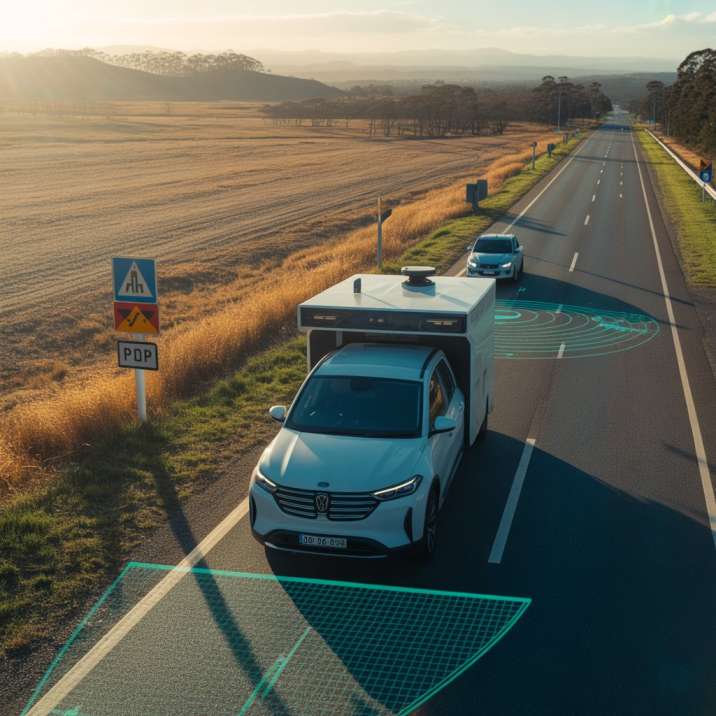Contact Us
RoadVision AI
Private Limited
Office No. 308 & 310, B Block
Ansal Chamber - 1, Bhikaji Cama Place,
Near Engineers India Limited (EIL) Bhawan, New Delhi - 110066
© 2024 | RoadVision AI | All rights reserved
Australia’s road infrastructure is vast, diverse, and essential to economic activity. For councils and state governments, maintaining and upgrading these assets requires accurate, up-to-date data. This is where a digital road asset inventory becomes essential. Supported by AI road data collection, these inventories give road authorities the insight needed to plan maintenance, ensure compliance with Austroads guidelines, and manage budgets more effectively.
In this blog, we’ll explore best practices for road asset management in Australia, focusing on how local councils and road agencies can improve decision-making through digitisation.

A road asset inventory is a comprehensive digital record of all physical elements within a road corridor. This includes:
Traditionally managed through spreadsheets or field notes, modern inventories now leverage AI and video-based data collection, making them more accurate, scalable, and insightful.
Explore how RoadVision AI's Road Inventory Tools automate this process using advanced sensors and machine learning.
According to Austroads’ Guide to Asset Management, maintaining an up-to-date inventory is the cornerstone of efficient and sustainable road asset management in Australia. It enables:
With ageing road networks and limited budgets, many Australian councils are shifting to AI-driven inspections to digitise inventories faster and more accurately.
The Austroads framework emphasizes standardised data formats and asset hierarchies. Your inventory should be compatible with Austroads’ AGAM (Austroads Guide to Asset Management) structure, ensuring:
Modern inventory practices rely on AI road data collection using:
These technologies are offered by solutions like RoadVision AI, enabling authorities to map thousands of kilometres in days rather than months.
Ensure that every asset collected is:
This supports predictive maintenance, helping councils prioritise areas based on deterioration trends. Learn how this ties into RoadVision's Pavement Condition Surveys.
Avoid fragmentation by centralising all inventory data in a digital platform that supports:
RoadVision provides such capabilities, simplifying how council asset management is executed.
Australia’s National Road Safety Strategy 2021–30 encourages using risk-based data for safer infrastructure. By linking asset data with audit insights, councils can detect issues like:
Explore RoadVision's AI Road Safety Audit Tools that seamlessly connect with inventory systems.
A one-time inventory is not enough. Best practice recommends:
With automated tools like RoadVision AI, these updates become easy and cost-effective.
By adopting best practices, local governments benefit from:
Read more about real-world implementations in RoadVision’s case studies.
Digital road asset inventory is no longer a future goal — it is a present-day necessity. Australian councils and infrastructure managers must adopt smart, AI-powered solutions to stay ahead of growing maintenance backlogs and limited budgets. Aligning with Austroads and using tools like RoadVision AI ensures accuracy, accountability, and better planning for years to come.
RoadVision AI is revolutionizing roads AI and transforming infrastructure development and maintenance with its cutting-edge innovations in AI in roads. By leveraging Artificial Intelligence, digital twin technology, and advanced computer vision, the platform performs comprehensive road safety audits, enabling early detection of potholes and other surface issues for timely repairs and improved road conditions.
The integration of pothole detection and data-driven insights through AI also enhances the accuracy of traffic surveys, helping address traffic congestion and optimize road usage. Focused on building smarter roads, RoadVision AI ensures full compliance with Austroads geometric design guidelines and IRC Codes, empowering engineers and stakeholders to reduce infrastructure costs, minimize risks, and improve road safety and transportation efficiency.
Explore how RoadVision AI can help digitise your assets, reduce inspection times, and support smarter planning.
Book a demo with us today: Contact Us
Q1. How often should road asset inventories be updated in Australia?
Best practice recommends updating road inventories annually or bi-annually, especially for high-use roads or council-level urban networks.
Q2. What does a digital road asset inventory typically include?
It includes pavements, signage, kerbs, drainage, lighting, and all roadside infrastructure — each geo-tagged and classified according to Austroads standards.
Q3. Can AI detect hidden defects during road asset inspections?
Yes, AI models can detect early signs of wear like cracking, potholes, or misaligned signage, enabling preventive action before major damage occurs.